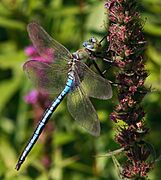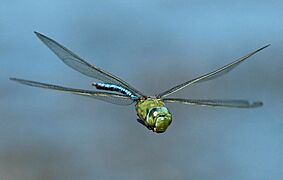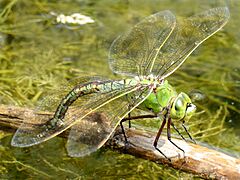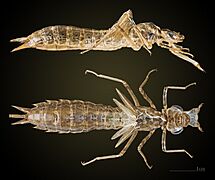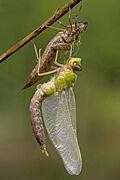Emperor (dragonfly) facts for kids
Quick facts for kids Emperor dragonfly |
|
|---|---|
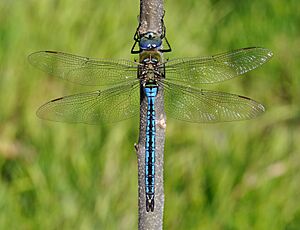 |
|
| Male Tenerife, Spain |
|
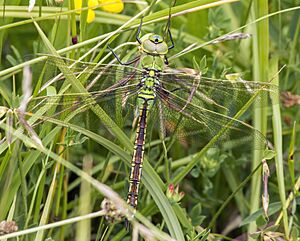 |
|
| female Oxfordshire, England |
|
| Conservation status | |
| Scientific classification | |
| Synonyms | |
|
The emperor dragonfly or blue emperor (Anax imperator) is a very large and impressive dragonfly. It belongs to a group called "hawker dragonflies." These amazing insects are some of the biggest dragonflies you can find in Europe, including the United Kingdom. They are known for their strong flight and beautiful colors.
Contents
What's in a Name?
The first part of the emperor dragonfly's scientific name, Anax, comes from an ancient Greek word. This word means "lord" or "ruler." The second part, imperator, is Latin for "emperor." So, its name literally means "ruler emperor," which fits its large size and powerful presence!
Where Do They Live?
Emperor dragonflies are found in many places around the world. They live across Africa, most of Europe, the Arabian Peninsula, and parts of Asia. Since the 1990s, these dragonflies have been spreading even further in Europe. They are now found more to the north and in higher places. For example, they were first seen in Denmark in 1994. Then, in 2002, they appeared in Sweden, and in 2004, they were first recorded in Scotland. Today, you can regularly find them in all three countries.
How to Spot an Emperor Dragonfly
The emperor dragonfly is a big and strong-looking insect. It usually grows to be about 73 to 82 millimeters (about 3 inches) long. Males are often a bit larger than females. Their wingspan, which is how wide their wings stretch, is usually around 104 millimeters (about 4 inches).
When they first come out of their larval stage, both male and female dragonflies look pale green with brown spots. Their legs are brown with a yellow base. Their wings start out black but turn yellowish-brown as they get older.
Male vs. Female
Male emperor dragonflies are easy to spot. They have a bright sky-blue body (called an abdomen) with a clear black stripe down their back. Their chest (thorax) and head are apple green. Their large, noticeable eyes are also blue.
Female emperor dragonflies look similar to males but are mostly green. They have the same markings, but their overall color is more green than blue.
Life and Habits
Emperor dragonflies are skilled hunters. They often fly high in the sky looking for food. They eat many different insects, including butterflies and other dragonflies. They also eat small creatures like tadpoles. If their prey is small, they will even eat it while flying!
Reproduction
These dragonflies need water to lay their eggs. They breed in many types of watery places, like large ponds and ditches. But they always need plenty of plants growing in the water. The female dragonfly lays her eggs inside water plants, such as pondweed. She always lays her eggs by herself.
The young dragonflies, called larvae, are very fierce. They can even affect what other kinds of animals live in the freshwater areas they colonize.
Adult Behavior
Adult male emperor dragonflies are very protective of their territory. They will chase away other males that come too close. This makes them quite hard to get near. During the summer, you might often see emperor dragonflies visiting gardens. They are especially common in the southern parts of Great Britain.



